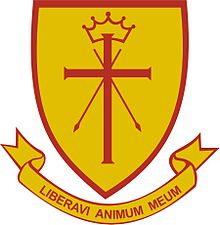Bernard Mizeki
Bernard Mizeki (sometimes spelt Bernard Mzeki; c. 1861 – 18 June 1896) was an African Christian
Early life
He was born Mamiyeri Mitseka Gwambe in
Missionary work
Through the work of the
He was sent to work in the Marandellas (
In March 1896, Mizeki married Mutwa (later "Lily"), an orphaned granddaughter of the Mangwende and a Christian convert. African Anglican priest Rev. Hezekiah Mtobi, recently arrived from
With the Mangwende's permission, Mizeki moved his growing community (several families, as well as young boys he was entrusted to teach), about two miles. They resettled across the river in a fertile area with a spring, but also near a sacred grove which was believed to be inhabited by spirits of the tribe's ancestral lions. Rather than make offerings to such spirits, Mizeki made the sign of the cross in the air, and carved crosses on some of the trees, and later felled some trees while preparing a field to plant wheat.[6]
Martyrdom
The
On the night of 18 June 1896, Mizeki was dragged from his home and stabbed. Mutwa found him still alive and went for help. She and others reported seeing a great white light all over that place, and a loud noise “like many wings of great birds”. Bernard's body had disappeared by their return.[4]
Mchemwa, a son of the Mangwende and an ally of the witch doctors, was later found responsible for Bernard's murder as well as the destruction of the mission settlement there.
Legacy and veneration

Bernard Mizeki's work among the Shona bore fruit, beyond the posthumous daughter Mutwa bore. After long years of mission work in Mashonaland, the first Shona convert to be baptised was one of the young men whom Mizeki had taught, John Kapuya. John was baptised only a month after Mizeki's death, on 18 July 1896. In 1899, a white Anglican priest returned to the area, and re-established the mission, as well as a school. Today, Bernard Mizeki College stands close to where he lived, and the Mangwende's kraal, above the village, is crowned with a large cross to commemorate Mizeki.[7]
In the 1930s, a chapel was built on the site of Mizeki's martyrdom, and consecrated in a great ceremony in June 1938. On the fiftieth anniversary of his death in 1946, an even larger celebration was held, attended by Mutwa and their daughter, and included a proclamation issued by Rhodesia's governor.[8]
Mizeki is honoured with a
Bernard is
In 1973, a church serving mostly Xhosa migrant workers, was dedicated to Bernard Mizeki in Paarl, South Africa. The Bernard Mizeki Men's Guild was established for Anglican lay men to promote and encourage the participation and nurturing of men's leadership in the life of the Church.[14] Composed largely of Xhosa-speaking migrant workers, Bernard Mizeki Guilds spread across South Africa. Guild members wear purple waistcoats, a special badge. Anglican migrant workers could identify with Bernard Mizeki as a fellow migrant who sacrificed himself for Christ. Members of the guild aspire to make the annual pilgrimage to the Mizeki festival in Zimbabwe.[15][16]
References
- ^ Noll & Nystrom 2011, p. 23.
- ^ "Bernard Mizeki, Catechist and Martyr in Africa".
- ^ Zvobgo 2009, p. 18.
- ^ a b c Kiefer.
- ^ Noll & Nystrom 2011, p. 27.
- ^ Noll & Nystrom 2011, p. 25.
- ^ Farrant 1966.
- ^ Noll & Nystrom 2011, p. 30.
- ^ Anon 2019.
- ^ Saints and Seasons 1993, p. 80.
- ^ AAPB 1989, p. 24.
- ^ Reynolds 2007, p. 200.
- ^ "The Calendar". The Church of England. Retrieved 2021-03-27.
- ^ Robert 2003, p. 133.
- ^ Robert 2011, p. 137.
- ^ Ranger 1987, p. 167.
Sources
- Anon (2019). Lesser Feasts and Fasts 2018. Church Publishing. ISBN 978-1-64065-235-4.
- Farrant, Jean Cecil (1966). Mashonaland Martyr: Bernard Mizeki and the Pioneer Church. Oxford University Press.
- Kiefer, James E. "Bernard Mizeki, Catechist and Martyr in Africa". Biographical sketches of memorable Christians of the past.
- Noll, Mark A.; Nystrom, Carolyn (2011). Clouds of Witnesses: Christian Voices from Africa and Asia. InterVarsity Press. ISBN 978-0-8308-6861-2.
- Ranger, Terence (1987). "Taking Hold of the Land: Holy Places and Pilgrimages in Twentieth-Century Zimbabwe". Past & Present. 117 (117): 158–194. JSTOR 650791.
- Robert, Dana L. (2011). Christian Mission: How Christianity Became a World Religion. John Wiley & Sons. ISBN 978-1-4443-5864-3.
- Snell, Margaret L. (1986). Bernard Mizeki of Zimbabwe. Mambo Press. ISBN 978-0-86922-393-2.
- Zvobgo, Chengetai J. M. (2009). A History of Zimbabwe, 1890-2000 and Postscript, Zimbabwe, 2001-2008. Cambridge Scholars Publishing. ISBN 978-1-4438-1599-4.
- Reynolds, Stephen (2007). For All the Saints: Prayers and Readings for Saints' Days. Toronto: ABC Publishing.
- Robert, Dana L. (2003). Mission churches. Southern African Missiological Society. ISBN 978-1-86888-284-7.
- Saints and Seasons. London: Harper Collins. 1993. Church of the Province of Southern Africa.
- An Anglican Prayer Book (Standard ed.). HarperCollins Publishers. 1989. ISBN 978-000-5991-80-0.
External links
- Oettle, Mike. "Mashonaland Martyr". Archived from the original on 27 October 2009. Retrieved 16 June 2006.
- Bernard Mizeki Men's Guild
